
|
The state of Baroda traces its origins to 1721 when Pilajirao Gaekwad, an officer in the Maratha Peshwa's army, was given the task of collecting the tax revenues from
major parts of what is now the state of Gujarat. The Gaekwads arose from humble origins; the name Gaekwad meaning "cow herd," but Pilaji's uncle Damaji had
distinguished himself as a soldier and had been given the title of Shamsher Bahadur, or "distinguished swordsman." (This explains why later coins from Baroda feature a
sword or scimitar as a dynastic symbol.) Pilaji continued in his uncle's footsteps, seizing the fort of Songadh from the Mughals and thereby earning his position of responsibility in
the Maratha state.
However, although the Gaekwads trace their origins to this time, it was not until considerably later that Baroda can be truly thought of as an independent state. The first coins
issued by the Gaekwads were issued by Manaji Rao (ruled 1789-93) and they followed the Maratha pattern of naming the Mughal emperor Shah Alam II, distinguishing themselves
only by the placement of an extra mark or letter to indicate the issuer. Manaji, for example, placed a Nagari letter ma on his coins.
After 1857, since the Mughal emperor had been deposed even formally, it no longer made any sense to issue coins in his name, so the designs were changed and coins were
issued in the name of "the Commander of the Sovereign Band," a title of the Gaekwad. The legends on these coins were still in Persian and the coins themselves were still hand-
struck. Finally, in stages during the 1870's, Nagari legends and different designs were introduced and also milled coins began to be issued, eventually featuring the portrait of the
Gaekwad on them.
|
 |
Anand Rao (1800-1819) |
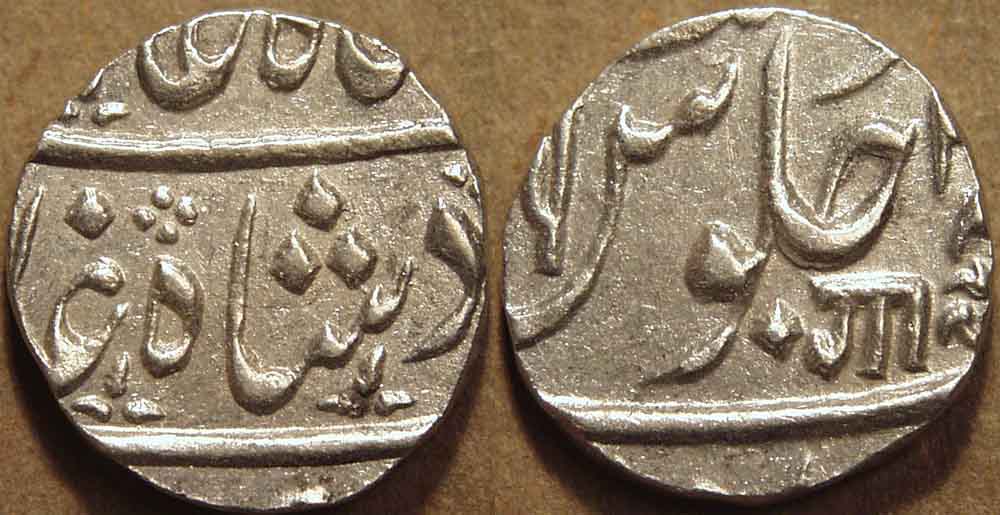
|
Anand Rao: Silver 1/2 rupee in name of Shah Alam II, Ahmedabad
Weight: 5.78 gm. Diameter: 17-18 mm Die axis: 11 o'clock
Legend, naming Shah Alam /
Legend, including Ahmedabad mintmark of ankus (elephant goad) in the julus and Nagari ga
Reference: KM C18
|
 |
The Nagari ga on this coin may have stood for "Gaekwad," but it was used in this form only on Anand Rao's Ahmedabad
coinage.
|

|
Anand Rao: Silver 1/2 rupee in name of Muhammad Akbar II, Baroda
Weight: 5.67 gm. Diameter: 17-18 mm Die axis: 3 o'clock
Legend /
Legend, including Baroda mintmark of curved sword (or scimitar) in the julus and Nagari aa
Reference: KM C26
|
 |
Although Muhammad Akbar's name is off the flan, we can identify this coin by the particular form of Nagari aa (we see just the
tip of the letter on the right edge of the flan on the reverse) ... this form was used only on Anad Rao's Baroda coins in the name of Muhammad Akbar II. On this coin, we also see
the curved sword or scimitar, the dynastic symbol of the Gaekwads.
|
 |
 |
 |
Sayaji Rao II (1819-1847) |

|
Sayaji Rao II: Silver rupee in name of Muhammad Akbar II, Baroda,
AH 1238, RY 18
Weight: 11.46 gm. Diameter: 22 mm Die axis: 12 o'clock
Legend naming Muhammad Akbar II, AH date 1238 (= 1822-23 CE) /
Legend, with scimitar left of the julus, RY date 18, Nagari sa (for Sayaji)
Reference: KM C38.1
|
 |
The coinage of Sayaji Rao II had three phases, most easily distinguished by the position of the scimitar on the reverse. This coin
belongs to the first phase, where the scimitar is represented vertically to the left of the julus, in continuation of the position in which it was represented on the coinage of
Anand Rao (see previous coin).
|

|
Sayaji Rao II: Silver 1/2 rupee in name of Muhammad Akbar II, Baroda,
AH 1244, RY 24
Weight: 5.72 gm. Diameter: 16 mm Die axis: 8 o'clock
Legend naming Muhammad Akbar II, AH date 1244 (= 1828-29 CE) /
Legend, with scimitar above the julus, RY date 24, Nagari sa off flan
Reference: KM C37.2
|
 |
This coin belongs to the second phase of Sayaji Rao's coinage, where the scimitar is represented horizontally above the julus.
KM lists the RY 24 half rupees with AH date 124x, indicating the lack of a specimen that showed the AH date clearly. This coin clearly shows the AH date of 1244, yielding the
combination 1244/24, which is known in the rupee denomination of this type.
|

|
Sayaji Rao II: Silver 1/2 rupee in name of Muhammad Akbar II, Baroda, RY 27
Weight: 5.67 gm. Diameter: 16 mm Die axis: 6 o'clock
Legend naming Muhammad Akbar II, AH date off flan /
Legend, with scimitar above the julus, RY date 27, Nagari sa (for Sayaji)
Reference: KM C37.2
|
 |
This coin shows the Nagari sa, which was off the flan on the previous specimen..
|

|
Sayaji Rao II: Silver rupee in name of Muhammad Akbar II, Baroda, RY 36
Weight: 11.51 gm. Diameter: 21 mm Die axis: 8 o'clock
Legend naming Muhammad Akbar II, AH date off flan /
Legend, with scimitar to right of the julus, RY date 36 (= 1840-41 CE), Nagari sa (for Sayaji)
Reference: KM C38.3
|
 |
This coin belongs to the third phase of Sayaji's coinage, where the scimitar is represented vertically to the right of the julus.
|

|
Sayaji Rao II: Copper paisa in name of Muhammad Akbar II, Baroda, sword type,
AH 1236/RY 16
Weight: 11.16 gm. Diameter: 20 mm Die axis: 9 o'clock
Legend naming Muhammad Akbar II, AH date 1236 (= 1820-21 CE) /
Legend, with scimitar to left of the julus, RY date 16, Nagari sa (for Sayaji)
Reference: KM C33.1
|
 |
Sayaji Rao's Baroda paisas form a most interesting series in that there is a whole series of different symbols featured on the reverse.
This coin features a scimitar. More Sayaji paisas can be seen here.
|
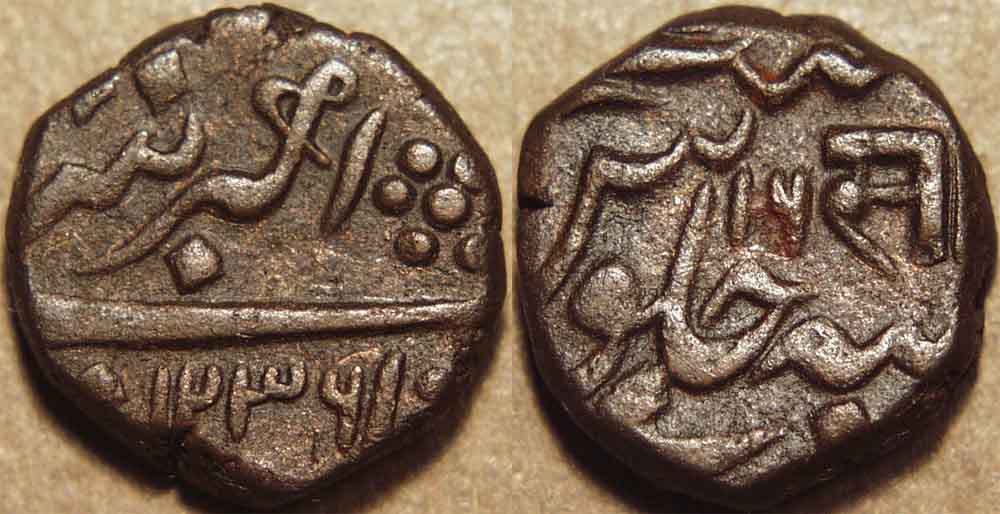
|
Sayaji Rao II: Copper 1/2 paisa in name of Muhammad Akbar II, Baroda, sword type,
AH 1236/RY 16
Weight: 5.87 gm. Diameter: 16 mm Die axis: 9 o'clock
Legend naming Muhammad Akbar II, AH date 1236 (= 1820-21 CE) /
Legend, with scimitar to left of the julus, RY date 16, Nagari sa (for Sayaji)
Reference: KM C31.1
|
 |
The half paisa version of the previous coin. The half paisas also carried different symbols. See more
here.
|

|
Sayaji Rao II: Copper paisa, Amreli, AH 1257
Weight: 6.88 gm. Diameter: 22-23 mm Die axis: 11 o'clock
Devanagari letters sa, ga with scimitar below, all within dotted border /
Legend, including AH date 1257 (= 1841-42 CE)
Reference: KM C29.6
|
 |
The Amreli paisas had a very different fabric. This reverse of this coin is clearly overstruck!
|
 |
 |
 |
Ganpat Rao (1847-1856) |
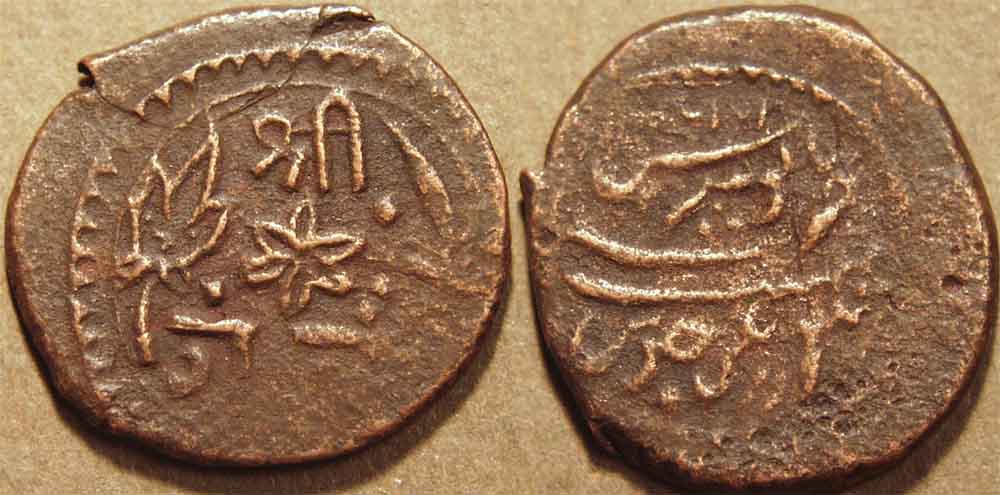
|
Ganpat Rao: Copper paisa, Amreli, AH 1257
Weight: 6.40 gm. Diameter: 21-23 mm Die axis: 4 o'clock
Devanagari letters sri above and ga ga below, with flower in the center,
leaf at left and scimitar at right, all within ruled and inward-rayed border/
Legend
Reference: KM C39
|
 |
Khande Rao (1856-1870) |

|
Khande Rao: Copper paisa, Amreli, AH 1277
Weight: 5.76 gm. Diameter: 20 mm Die axis: 3 o'clock
Devanagari letters sri above and kha ga below, with leaf sprig in the center,
flower at left and scimitar at right, all within ruled and inward-rayed border/
Legend, including AH date 1277 (= 1860-61 CE)
Reference: KM Y1
|

|
Khande Rao: Copper paisa, Amreli, AH 1277
Weight: 6.27 gm. Diameter: 18 mm Die axis: 2 o'clock
Devanagari letters sri above and kha ga below, with leaf sprig in the center,
flower at left and scimitar at right, all within ruled and inward-rayed border/
Legend, including AH date 1277 (= 1860-61 CE)
Reference: KM Y1
|
 |
Malhar Rao (1870-1875) |

|
Malhar Rao Silver rupee, Baroda mint, AH 1288
Weight: 11.47 gm. Diameter: 20 mm Die axis: 6 o'clock
Legend /
Remnants of Persian legend, scimitar at left, Nagari maa gaa (for Malhar Rao),
AH date 1288 (= 1871-72 CE) below.
Reference: KM Y21
|
 |
It is interesting to see how the Persian legend on the reverse of Malhar Rao's coinage has been shunted aside; pride of place is given
to the Nagari letters identifying the king, the scimitar, and the AH date, which has migrated to the reverse.
|

|
Malhar Rao Silver 1/2 rupee, Baroda mint, AH 1288
Weight: 5.68 gm. Diameter: 15 mm Die axis: 1 o'clock
Legend /
Remnants of Persian legend, scimitar at left, Nagari maa gaa (for Malhar Rao),
AH date 1288 (= 1871-72 CE) below.
Reference: KM Y20
|
 |
The half rupees are scarcer than the full rupees.
|
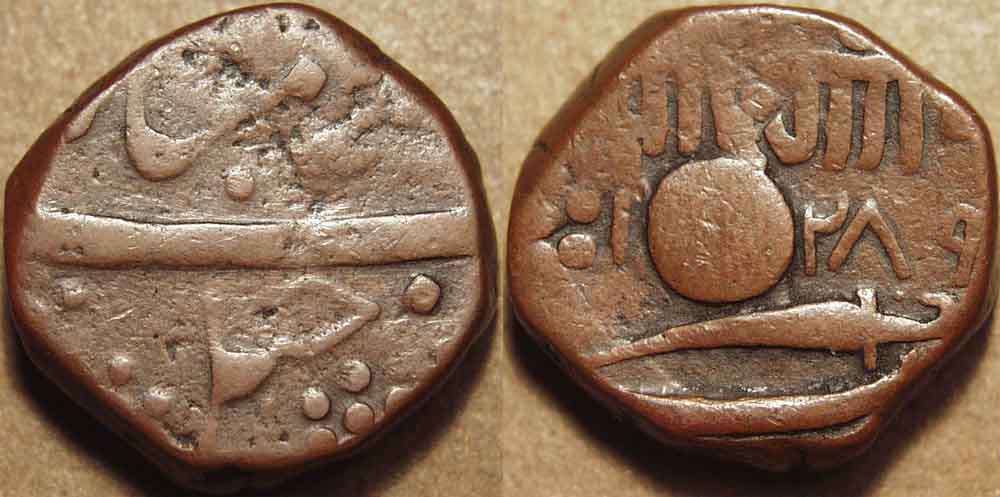
|
Malhar Rao Copper double paisa, Baroda mint, AH 1289
Weight: 15.45 gm. Diameter: 20-21 mm Die axis: 1 o'clock
Legend /
Nagari maa gaa (for Malhar Rao), sphere or circle below,
flanked by AH date 1289 (= 1872-73 CE), scimitar below.
Reference: KM Y17
|
 |
Malhar Rao's copper coinage continued featuring the shaded ball or circle seen on the late coins of Sayaji Rao II.
|
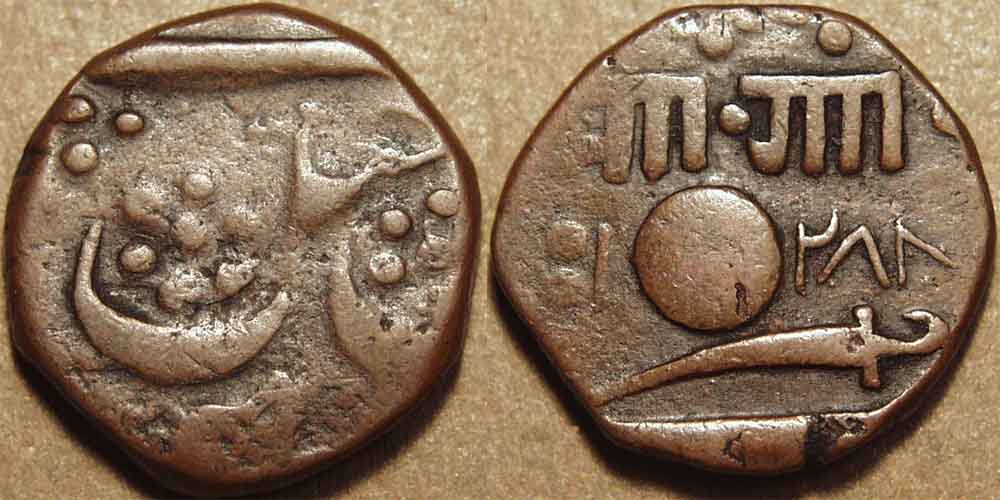
|
Malhar Rao Copper paisa, Baroda mint, AH 1288
Weight: 7.73 gm. Diameter: 19-21 mm Die axis: 9 o'clock
Legend /
Nagari maa gaa (for Malhar Rao), sphere or circle below,
flanked by AH date 1288 (= 1871-72 CE), scimitar below.
Reference: KM Y16
|
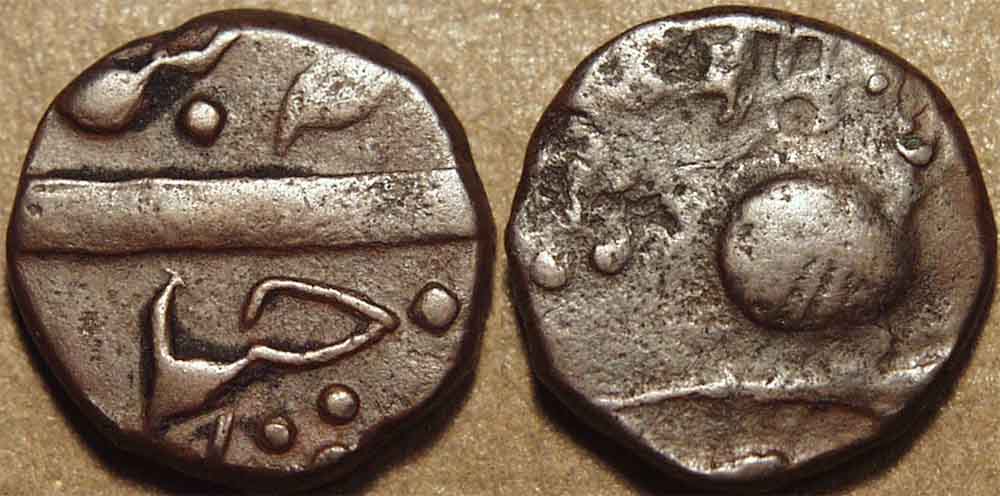
|
Malhar Rao Copper paisa, Baroda mint, AH 1288
Weight: 3.85 gm. Diameter: 15 mm Die axis: 12 o'clock
Legend /
Nagari maa gaa (for Malhar Rao), sphere or circle below,
flanked by AH date (not visible), scimitar below.
Reference: KM Y15
|
 |
Sayaji Rao III (1875-1938) |
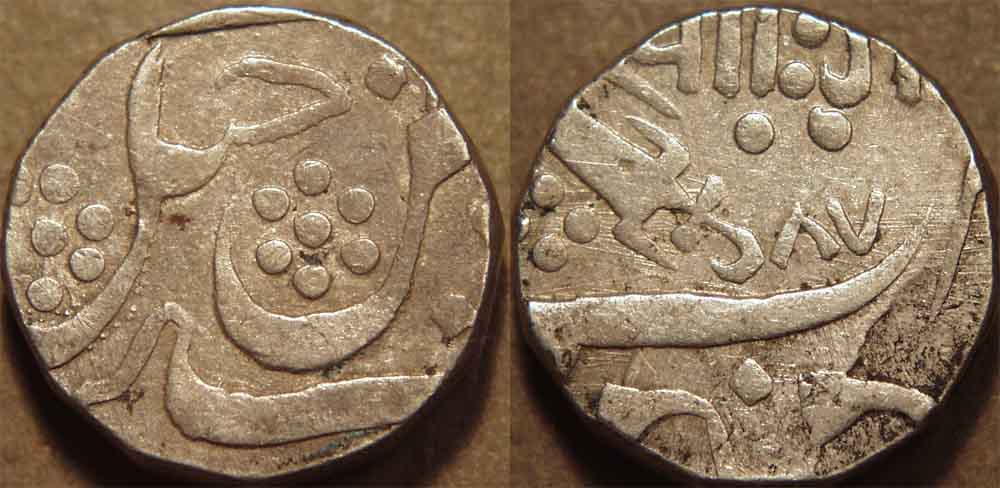
|
Sayaji Rao III: Silver rupee, Baroda mint, error date?
Weight: 10.79 gm. Diameter: 20 mm Die axis: 9 o'clock
Legend /
Remnants of Persian legend, scimitar at left, Nagari saa gaa (for Sayaji Rao III),
date 87 (!!) below.
Reference: KM Y29
|
 |
A most unusual coin, waiting for an explanation! The position of the scimitar and the letters saa gaa on the reverse identify this
as a coin of Sayaji Rao III. However, his hammered coinage carries a full AH date on the reverse and includes only the dates 1292-1302. This coin carries only the date 87. If it
were shorthand for AH 1287, the date is 5 years too early for the reign of Sayaji Rao III! Another possibility is that the coin was issued by Malhar Rao in the first year of his reign
(AH 1287), but his coins also normally carry a full AH date and, in any case, it seems almost certain that the Nagari letter identifying the king is saa, not maa. So
perhaps this is an error date, or some other explanation is required!
|

|
Sayaji Rao III: Silver rupee, Baroda mint, VS 1955
Weight: 11.37 gm. Diameter: 28 mm Die axis: 12 o'clock
Bust of king right, wearing jeweled turban, Nagari legend around:
sri sayaji rao / ma. gaekwad /
Nagari denomination in two lines: ek / rupaya, sword, and
VS date 1955 (= 1897 CE) below, wreath around
Reference: KM Y36a
|
 |
Portrait coins were introduced for the first time in the gold series in VS 1942 and in the silver series in VS 1948. Note the discarding of
AH dates, replaced by dating in the Vikram era of 57 BCE.
|
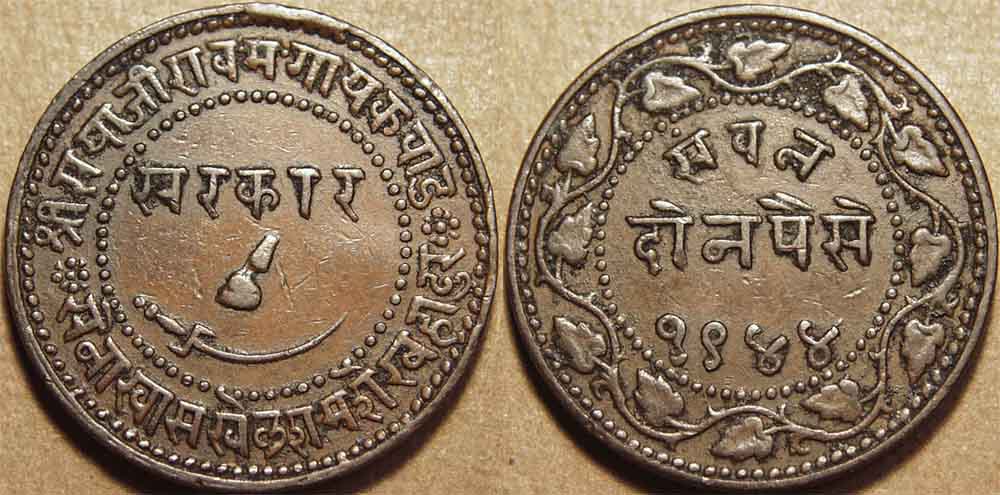
|
Sayaji Rao III: Copper double paisa, heavy type, Baroda, VS 1944
Weight: 16.33 gm. Diameter: 30 mm Die axis: 2 o'clock
Horse hoof, scimitar below, Nagari legend sarkar above,
circular legend in Nagari around within two dotted borders:
sri sayaji rao . ma . gayakwad // sena khas khel shamsher bahadur /
Nagari legend naming the denomination: don paise, Nagari samvat (year) above,
date 1944 (= c. 1887 CE) below, circular leaf wreath within two dotted borders around
Reference: KM Y32.2
|
 |
The first milled coins were produced in limited numbers towards the end of Malhar Rao's reign, but the switch took place over several
years, through the 1880's. At this time, the use of Persian letters was eliminated, to be replaced by Devanagari, and entirely new designs were initiated. Also, the use of the AH
date was dropped, replaced by dates in the Vikram era of 57 BCE.
The early milled coins of Sayaji Rao were heavier than the later ones; this coin is of the heavy type, over 16 gm, on a large 30 mm flan, which is 3 mm thick. The letter ma
in the obverse legend presumably stood for "maharaj." We see the old title shamsher bahadur originally given to Damajirao Gaekwad in 1720, and also the title sena
khas khel, or "Commander of the Sovereign Band."
|

|
Sayaji Rao III: Copper double paisa, light type, Baroda, VS 1948
Weight: 13.05 gm. Diameter: 30 mm Die axis: 12 o'clock
Horse hoof, scimitar below, Nagari legend sarkar above,
circular legend in Nagari around within two dotted borders:
sri sayaji rao . ma . gayakwad // sena khas khel shamsher bahadur /
Nagari legend naming the denomination: don paise, Nagari samvat (year) above,
date 1948 (= c. 1891 CE) below, circular leaf wreath within two dotted borders around
Reference: KM Y32.2a
|
 |
The weight of the copper coinage was reduced in VS 1948 (= 1891 CE), with the double paisa being cut from above 16 gm. to around
13 gm., as on this coin. The diameter of the coin was kept the same at 30 mm, but the thickness was reduced from around 3 mm. to around 2.5 mm.
|

|
Sayaji Rao III: Copper paisa, Baroda mint, VS 1940
Weight: 7.50 gm. Diameter: 24 mm Die axis: 1 o'clock
Horse hoof, scimitar below, Nagari legend sarkar above,
circular legend in Nagari around within two dotted borders:
sri sayaji rao . ma . gayakwad // sena khas khel shamsher bahadur /
Nagari legend naming the denomination: ek paisa, Nagari samvat (year) above,
date 1940 (= c. 1883 CE) below, circular leaf wreath within two dotted borders around
Reference: KM Y31.1
|
 |
The first milled paisas of Sayaji Rao were issued in VS 1940 and had the word sarkar on the obverse in a curved configuration; this
coin has that word off-center to the left. Presumably this coin represents one of the first, if not the first, die for the new milled coinage. The die cutter had not mastered the art of
centering the legend, as was achieved in all subsequent dies.
|

|
Sayaji Rao III: Copper paisa, Baroda mint, VS 1940
Weight: 7.81 gm. Diameter: 24 mm Die axis: 12 o'clock
Horse hoof, scimitar below, Nagari legend sarkar above,
circular legend in Nagari around within two dotted borders:
sri sayaji rao . ma . gayakwad // sena khas khel shamsher bahadur /
Nagari legend naming the denomination: ek paisa, Nagari samvat (year) above,
date 1940 (= c. 1883 CE) below, circular leaf wreath within two dotted borders around
Reference: KM Y31.1
|
 |
Here the word sarkar on the obverse is centered. However, the coin still appears to belong to an experimental phase of the
coinage, since the circular border wreath on the reverse resembles the design on the previous coin rather than later coins. The letters on the reverse are also uncharacteristically
large.
|
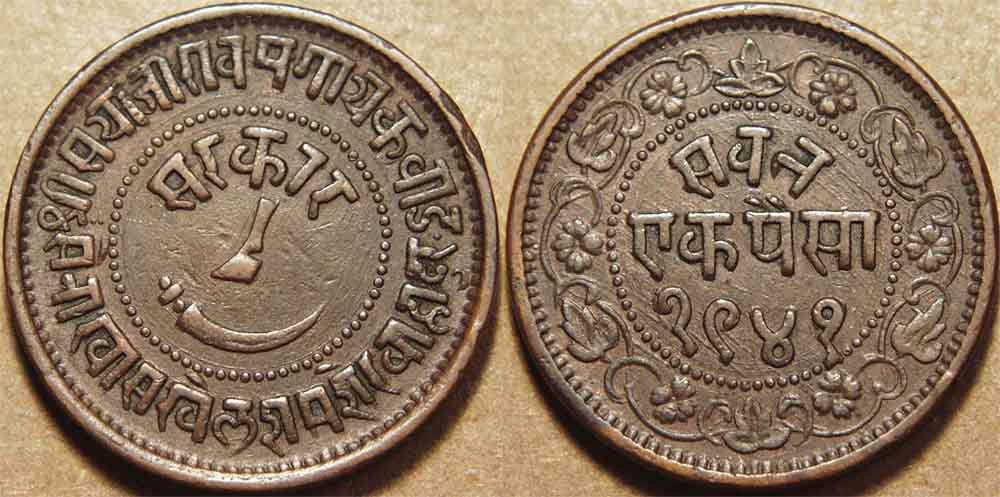
|
Sayaji Rao III: Copper paisa, Baroda mint, VS 1941
Weight: 8.91 gm. Diameter: 25 mm Die axis: 10 o'clock
Horse hoof, scimitar below, Nagari legend sarkar above,
circular legend in Nagari around within two dotted borders:
sri sayaji rao . ma . gayakwad // sena khas khel shamsher bahadur /
Nagari legend naming the denomination: ek paisa, Nagari samvat (year) above,
date 1941 (= c. 1884 CE) below, circular leaf wreath within two dotted borders around
Reference: KM Y31.1
|
 |
This coin is distinguished in that the obverse legend is written in very square "boxy" letters. Also notice how the circular wreath on the
reverse border has evolved further ... the scroll work near the bottom is very different and the flowers are now composed of four compound petals rather than the daisy-like 9-10
petalled flowers on the issues of 1940.
|

|
Sayaji Rao III: Copper paisa, Baroda mint, VS 1947
Weight: 8.15 gm. Diameter: 25 mm Die axis: 2 o'clock
Horse hoof, scimitar below, Nagari legend sarkar above,
circular legend in Nagari around within two dotted borders:
sri sayaji rao . ma . gayakwad // sena khas khel shamsher bahadur /
Nagari legend naming the denomination: ek paisa, Nagari samvat (year) above,
date 1947 (= c. 1890 CE) below, circular leaf wreath within two dotted borders around
Reference: KM Y31.2
|
 |
This coin represents an evolution of the Sayaji Rao paisas to where the word sarkar on the obverse is now in a horizontal
(rather than the previous curved) configuration; also, the flower and leaf wreath border on the reverse has now devolved to a simple leaf border.
The straight legend coins are divided into two broad classes: a heavy weight series of about 8.2 gm. and a light weight series of about 6.2 gm. issued after the reform of VS
1948. This coin belongs to the heavy weight series. Further, this coin is distinguished from previous issues in that the two parts of the obverse circular legend are separated by
single dots within circles. Also, the letter e in the denomination ek is "closed" rather than "open ... the second vertical line bends back towards the first, as
opposed to the feature of previous issues in which the second vertical simply dangled downward without bending back.
|
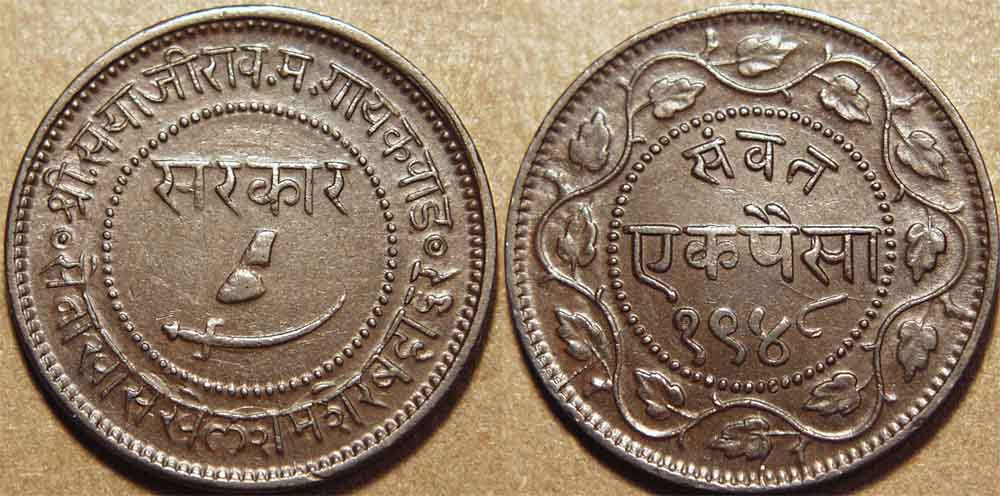
|
Sayaji Rao III: Copper paisa, Baroda mint, VS 1948
Weight: 6.18 gm. Diameter: 25 mm Die axis: 9 o'clock
Horse hoof, scimitar below, Nagari legend sarkar above,
circular legend in Nagari around within two dotted borders:
sri sayaji rao . ma . gayakwad // sena khas khel shamsher bahadur /
Nagari legend naming the denomination: ek paisa, Nagari samvat (year) above,
date 1948 (= c. 1891 CE) below, circular leaf wreath within two dotted borders around
Reference: KM Y31.2a
|
 |
This coin belongs to the later, low weight series and has a thinner planchet than the previous coin. In all other respects, it resembles
the immediately preceding issues.
Curiously, the latest edition of Krause does not distinguish between the low weight series and the heavier weight coins of the earlier years (previous editions did). However, it is
clear that there was a reduction of weight starting in VS 1948; this can be seen in the 2-paisa coins as well.
|

|
Sayaji Rao III: Copper pai, Baroda mint, VS 1944
Weight: 2.51 gm. Diameter: 19 mm Die axis: 1 o'clock
Horse hoof, scimitar below, Nagari legend sarkar above,
circular legend in Nagari around within two dotted borders:
sri gayakwad // barode /
Nagari legend naming the denomination: ek pai, Nagari samvat (year) above,
date 1944 (= c. 1887 CE) below, circular leaf wreath within two dotted borders around
Reference: KM Y30.2
|
 |
This coin belongs to the heavy weight series. Note the shortened obverse legend because of the reduced space and the "open"
e in the denomination ek.
|
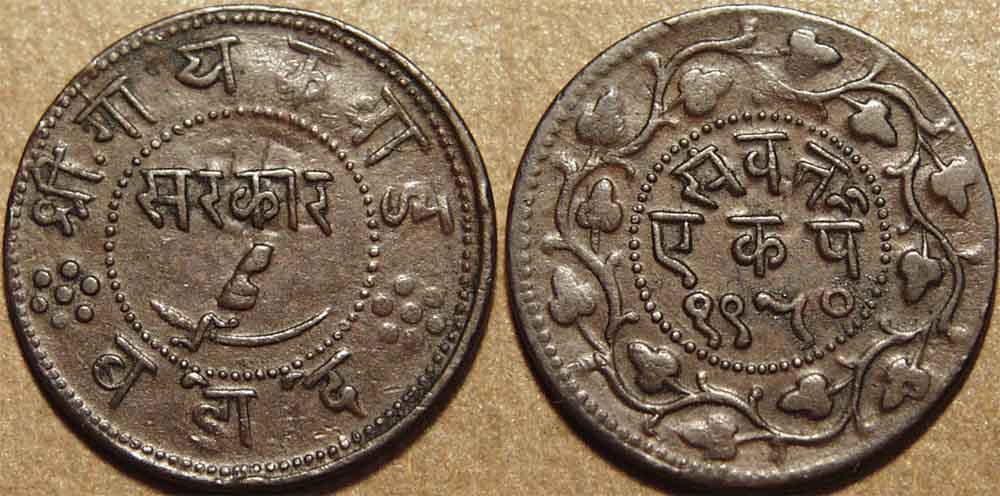
|
Sayaji Rao III: Copper pai, Baroda mint, VS 1950
Weight: 2.17 gm. Diameter: 19 mm Die axis: 12 o'clock
Horse hoof, scimitar below, Nagari legend sarkar above,
circular legend in Nagari around within two dotted borders:
sri gayakwad // barode /
Nagari legend naming the denomination: ek pai, Nagari samvat (year) above,
date 1950 (= c. 1893 CE) below, circular leaf wreath within two dotted borders around
Reference: KM Y30.3
|
 |
This coin belongs to the low weight series. Note the "closed" e in the denomination ek and the smaller circle within
which the reverse legend is crammed. Also, the rosettes separating the two parts of the obverse circular legend are bigger here, while the word sarkar is written in much
smaller letters.
|
|
|